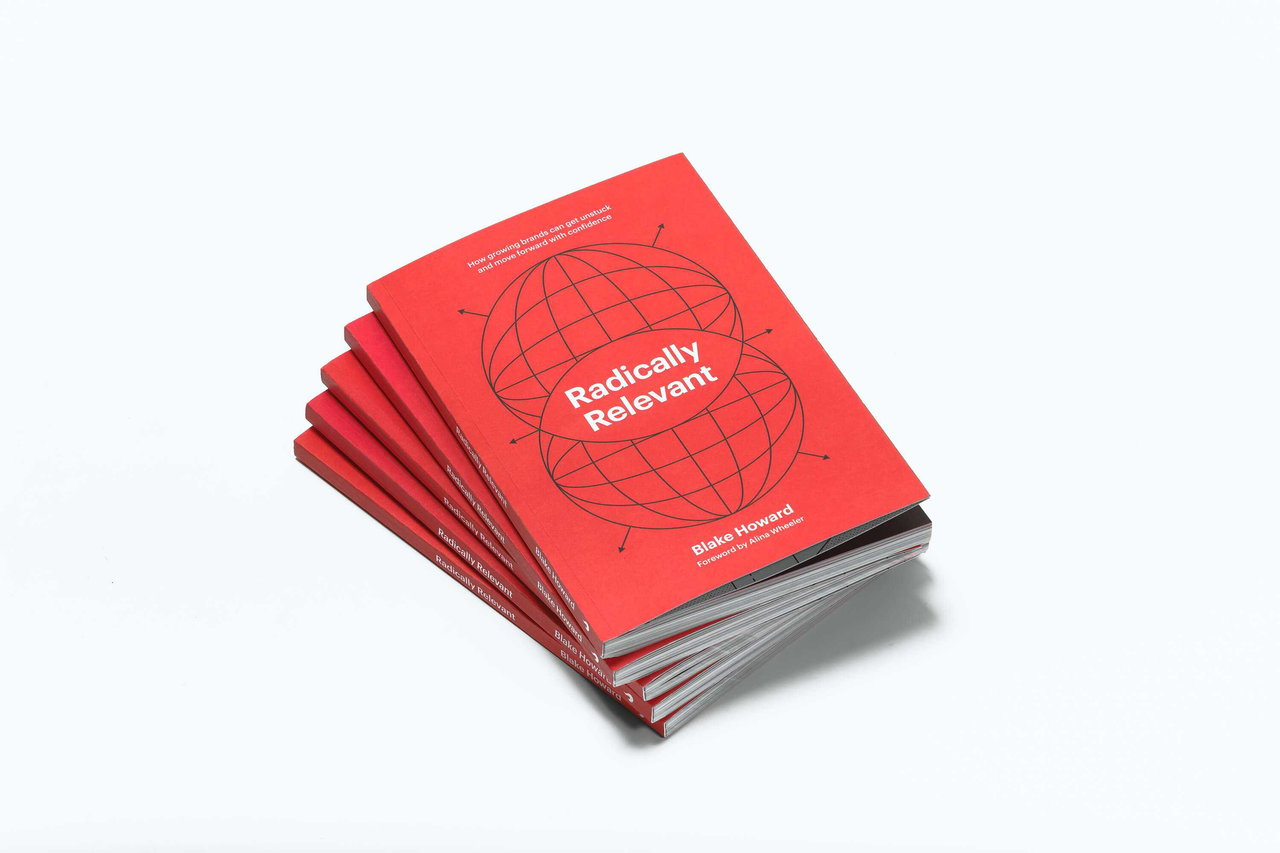Chief Marketing Officers have challenges. Brand shouldn't be one of them.
- Three quarters of missed revenue expectations and a fresh new competitor.
- Private equity-fueled growth and a set of new offerings that don’t really fit with your message.
- Years of sales-focused efforts, leaving behind a neglected and stale brand.
- Leads and qualified opportunities leaking left and right.
- Comments from HR about lower-than-expected applicants.
And everyone is looking at the CMO for answers.
Some of these challenges demand a brand refresh, or possibly a full rebrand. More often than not, the CMO is the executive who carries the weight of that change as you steward the brand.
Successful brand evolutions are the crowning jewel on any CMO’s resume. More importantly, they can be a transformative process with a tremendous impact on the bottom-line results. However, before you start dreaming up those LinkedIn accolades or cool creative trophies, you first need a plan to get the project off the ground. You need alignment on the real problem to solve, managed expectations, political air cover, budget approval, and a plethora of social capital to pull this off.
You’ve got a lot to do, so let’s get started.
Define the real problem
Clearly state and align on the challenge to be solved.
Aligning on the challenge will help you get buy-in and traction for the resources required for the work ahead. Additionally, it will set you up for success on the back end when you’re the one accountable to show results. The key to measuring any success related to a brand refresh is getting clear on the problem to be solved.
Need help pinpointing the problem? Take our assessment and find out.
In the meantime, ask yourself and others inside the company:
- How clearly do outsiders understand our brand’s personality, value, and offerings?
- How different from our competitors do we sound, look, perform, and otherwise present ourselves to the market?
- How consistent and recognizable is our brand in the market?
- How efficient are our marketing and communication efforts? In other words, is Sam from Sales still using those bad stock photos? Is Haley from HR still using Comic Sans? Is Dan from Design wanting to “get creative with this one”?
- Are ideal new customers drawn to our brand?
- Are our existing customers excited to tell others about us?
- How aligned are our internal teams on the positioning of the company? Do day-to-day decisions reinforce that positioning?
Document the answers to these questions and share the results back with the people you talked to. You can also share the brand assessment with others on your team to compare your results.
The strength of your brand will be tested by any of the challenges above, but homing in on the single most important problem to be solved is key to success. This will be the litmus test for budget approval, executive buy-in, and good decision-making once the work starts.
Build the right budget
The amount of change will drive the investment needed.
Once you have a clearer picture on the problem to be solved, you can better consider the funds required for the task. Brand changes can be evolutionary (retain key recognizable assets) or revolutionary (create new, distinct assets). The smaller the visual change, the smaller the budget needed to cover producing new materials, since evolutionary identities can co-exist in the market. However, if you decide to swing for the fences, you’ll want to replace brand materials as quickly as possible. Here are some key questions to consider:
- Will your change be evolutionary or revolutionary?
- Will you launch in association with a significant event?
- What might be needed for a marketing splash on Day 1 of the launch?
- What materials will need to be produced on Day 1, Day 30, Day 60 and beyond?
- What materials can slowly be replaced as existing inventory runs out?
Secure air cover
Four ways to get C-suite buy-in.
Best case, the need for a rebrand is undeniable, and mandated by the board, the CEO, or a strategic plan. Worst case, you're swimming upstream to get funding and need to convince others of the ROI. Here are a few tips to build more momentum and to prove your point.
- Connect brand efforts back to the current company focus or needs. Hint: It’s almost always the challenge your CEO is focused on right now.
- Revenue – winning and closing deals more often and more easily
- Hiring – attracting and retaining top talent
- Innovation – focusing effort more on new/innovative thinking
- Acquisitions – creating attraction for positive M&A activity
- Operational Improvement – creating clarity and unity internally to minimize confusion, bottlenecks, or going rogue
- Visualize the problem in simple and powerful ways.
- Collect photos or examples that illustrate the main problem. If inconsistency or market confusion is the issue, consider collecting the disparate marketing materials and putting them on one slide to help the CEO feel the problem.
- Use a powerful stat. Many studies show the value of brand investment, but here are some of our favorites: According to McKinsey & Company, businesses that embrace design generate 32% more revenue and 56% more shareholder returns, on average. And presenting a brand consistently across all platforms can increase revenue by up to 23%.
- Show how other organizations or inspirational brands solved similar problems. Analogs help play-it-safe leaders feel comfortable and catch a vision of what’s possible.
- Plant seeds and water (then keep watering).
-
- Depending on the dynamics of your leadership team, consider planting small seeds with those around the CEO. Socialize the idea of brand as a solution with some of your peers.
- See if you can make connections between their priorities and your desired brand improvements.
- Share the radically relevant assessment with your C-suite and see where you align.
- If there is a gap between the scores, facilitate a discussion to build a shared understanding.
- Use an aggregate score to show strengths, opportunities, and industry benchmarking.
Still having trouble getting buy-in? We like Dan and Chip Heath’s advice in their book Switch on “shrinking the change.” Instead of getting a rebrand fully funded, start with a brand audit, internal brand survey, or external audience research. These smaller projects can get the ball rolling and make the challenge at hand clearer.
Manage timeline expectations
How long will this take, really?
You’re not going to like this, but successful brand changes take time. More time than you want. How much time? Well, it depends.
A comprehensive rebrand effort can take anywhere from 3 months to 3 years. Your precise timeline? Well, that comes down to these key areas:
- The number of stakeholders giving feedback during the process.
- The decisiveness of leadership.
- The amount of effort needed to go-to market with the brand changes.
Here’s a list of possible phases of work related to a brand refresh. Similar to budgeting, the greater the problem, the greater the effort (and the longer the timeline).
Research – Qualitative or quantitative audience studies are the largest influence on timelines in this phase. Audits, assessments, internal focus groups and interviews are a lighter lift since they are easier to coordinate. Estimating 1-3 months for research is a fair assessment. Removing research effort saves time but leaves more guesswork in the latter stages of the project.
Brand Strategy – Clearly defining your ideal audience profile(s), determining radically relevant positioning and personality attributes will also take you 1-3 months. A smaller circle of stakeholder feedback paired with decisive leadership will help save time.
Naming – Typically 1-2 months, this process can stretch well beyond comfort or expectation. Similar to the strategy process, this duration is all about decision-making, feedback, and overall name criteria. International trademarks, dictionary or suggestive words, and dot com URL requirements make for a hard task and a long timeline. The decision-making process following the naming presentation can drag on for weeks, if not months. Planning ahead for any cultural, lingual, or consumer testing will help save your unexpected delays.
Visual and Verbal Identity – Considering logos, color, type, voice, messaging, and the overall look and feel should take 2-3 months. Similar to other phases, the amount of stakeholders and complexity of your organization will drive this timing up or down. Evolutionary changes notably reduce the effort, whereas revolutionary changes require a more thorough process.
Launch – From websites to integrated campaigns to celebratory events, consider this the Wild West. 1-6 months is an honest assessment. Simple roadshow reveals will be on the quicker side, with complex websites adding significant time (and budget). Even though this phase is highly customized, it might be the most important. To use a sports analogy, you don’t want to fumble on the one-yard line.
If you still have the need for speed, try:
- Scheduling key meetings well in advance and getting leadership’s commitment to attend and make them a priority
- Keeping the decision making team small (3-5 people)
- Making quick decisions at key points in the brand project
- Parallel pathing workstreams. For example, starting the website refresh project early. Kick off audits, content planning, wireframing, and UX alongside the brand refresh work. Layer in the UI once the brand initiative is finished.
Communicate like your career depends on it
Paving the way for agreement.
No matter how excellent the strategic and creative work is, you’ll need to do some selling once it comes to internal alignment. Marketing, creative, product, sales, and even HR will need to weigh in on the process. Their input is critical. Not because any one group has the right answer, but because brand prevails across all departments within your organization and you need key leaders to become key contributors to the process (and defenders of the outcome).
Planning your alignment and approval process ahead of time can save you, well, time. Heartache even more so.
There’s a difference between getting input and making decisions. Everyone can give you feedback, but you won’t be able to appease everyone or implement all of it (it's like they say, a horse designed by a committee is a camel). Set the stage up front for who will give feedback and who will make decisions.
We recommend having a core brand team (3-5 people max) that will be responsible for the decision-making. Additionally, you can have a larger group (10-12 people max) that will be highly involved in the process and will give feedback every step of the way. Outside of that group, consider getting feedback from additional stakeholders at the beginning of the project (to help them feel heard) and then keep them updated on the decisions made towards the end of the process.
If your culture is creative, curious, and passionate, using platforms like Loom and Slack to post video updates early and often helps employees feel in the loop. Just be mindful of the guaranteed barrage of opinions.
Ultimately, the decision must come down to you and your CEO, but knowing a larger group has your back can be a much needed source of comfort.
Find the right partner or roll your own
Obviously, we’re a bit biased on this one.
Several brands tackle brand challenges in-house. There are many pros for doing so. Those helping solve the problem(s) already know the brand more intimately than any outsider. You will have more control over the work as well. So if you have a specific vision or direction in mind, working directly with your team will likely save you time and money. However, most companies don't have the capacity in-house to add a brand project on top of an existing stack of work.
If you decide to find an agency partner who can provide a more outside and objective perspective, here are a few key questions to consider:
- Are they specialized in branding, or is it just one more bullet on their long list of services?
- Do they have experience in your industry?
- Do you have mutual values and working styles?
- Do you personally connect with the team you’d be working with? (You’ll be spending a lot of time together, after all.)
- Would you trust them to lead you to the best answer for your business?
- Do they have a process that gives you confidence in a good outcome?
In conclusion
Even though there is a lot at stake with a rebrand or refresh, many have gone before you and have successfully navigated the challenges ahead. You can as well, but it all starts with the right plan. Getting clear on the real problem, building the right budget, securing c-suite support and managing expectations are all critical steps along towards your rebrand glory.






